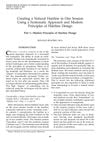TLDR Hair transplantation, especially follicular unit micrografting, was the top treatment for male pattern baldness, with a focus on natural results and ongoing improvements in both surgical and medical management.
In 2002, hair transplantation, particularly follicular unit micrografting, was the leading treatment for male pattern baldness, which affected over 30 million men and an increasing number of women. This technique, which transplants hair in its natural groupings, had become the most popular due to its natural-looking results. The document also discussed the importance of careful planning and technique in hair restoration to account for the progressive nature of baldness and to minimize scarring. It covered the debate over achieving naturalness and density, with some surgeons combining follicular units and minigrafts. Studies suggested that CO₂ lasers caused less thermal damage and that a combination of low-power CO₂ and Erbium:YAG lasers was optimal. The angle of recipient site placement and hairline design were crucial for a natural appearance, and eyebrow reconstruction was also addressed. Medical treatments like Minoxidil and Finasteride were noted to be better at preserving hair than regrowing it. The document concluded that while surgical hair replacement was being refined, there was a need for better medical management of hair loss in both men and women.
3 citations
,
September 2001 in “Dermatologic Surgery” Adding a 5 W CO2 laser to the Er:YAG laser improved bleeding control without harming hair growth or causing damage.
 1 citations
,
July 2001 in “Hair transplant forum international”
1 citations
,
July 2001 in “Hair transplant forum international” The conclusion compares the effectiveness of different hair transplant techniques.
 8 citations
,
June 2001 in “International Journal of Cosmetic Surgery and Aesthetic Dermatology”
8 citations
,
June 2001 in “International Journal of Cosmetic Surgery and Aesthetic Dermatology” Use shallow cuts, small tissue removal, careful suturing, and keep the area moist to reduce scarring in hair transplants.
 9 citations
,
June 2001 in “International Journal of Cosmetic Surgery and Aesthetic Dermatology”
9 citations
,
June 2001 in “International Journal of Cosmetic Surgery and Aesthetic Dermatology” A single session hair transplant can create a natural hairline using a detailed technique with specific zones and careful planning.
 3 citations
,
June 2001 in “International Journal of Cosmetic Surgery and Aesthetic Dermatology”
3 citations
,
June 2001 in “International Journal of Cosmetic Surgery and Aesthetic Dermatology” Using both follicular units and slit grafts for hair transplants may give better hair density and graft survival.
 8 citations
,
April 2001 in “Dermatologic Surgery”
8 citations
,
April 2001 in “Dermatologic Surgery” Michael L. Beehner proposed a standardized way to describe balding areas on the scalp to help hair restoration experts communicate better.
 89 citations
,
January 2001 in “Dermatologic Surgery”
89 citations
,
January 2001 in “Dermatologic Surgery” Hair loss in women is common, starts in late 20s, and affects 30% of women over 50.
 5 citations
,
January 2001 in “Hair transplant forum international”
5 citations
,
January 2001 in “Hair transplant forum international” Different hair transplant methods affect how many hair grafts survive.
 13 citations
,
November 2018 in “Annals of Plastic Surgery”
13 citations
,
November 2018 in “Annals of Plastic Surgery” Nonshaven follicular unit extraction is a good hair transplant option that doesn't require shaving and can transplant up to 3000 grafts daily.
December 2010 in “SciVee” January 2006 in “The Chinese Journal of Dermatovenereology” Hair transplantation is a safe and effective treatment for hair loss with long-lasting results.
21 citations
,
August 2000 in “Dermatologic Surgery” The technique reduces hair loss and increases hair density in early baldness.
2 citations
,
November 1987 in “PubMed” Male pattern baldness can be managed with treatments like minoxidil and hair surgery.









